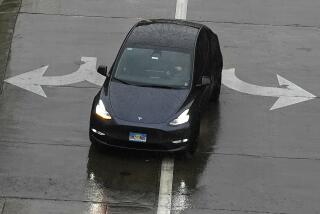Going Full Throttle : With the Help of Light Trucks, Last Year’s Strong Auto Sales Expected to Continue in ’97
- Share via
DETROIT — Riding the American obsession with gas-guzzling trucks, U.S. auto sales rose a strong 2% in 1996. And while sales slowed in December, the outlook is for a continuation of good times.
Auto makers sold an estimated 15.1 million cars and trucks, making last year one of the best ever, according to industry reports released Friday. Sales in California are expected to come in slightly better than the national rate.
A quintet of Japanese and Korean auto makers with U.S. headquarters in Orange County accounted for sales of just over 600,000 cars and trucks, almost 45% of them made at manufacturing plants in the U.S.
The Orange County importers--Hyundai, Kia, Mazda, Mitsubishi and Suzuki--turned in a mixed performance for the year, though, with total sales down 6.1% from 1995. Most analysts say the five so-called third-tier importers lost sales to the domestic car companies rather than to other foreign car makers.
Mitsubishi Motors Sales of America, the Cypress-based importer and distributor of Mitsubishi vehicles, saw sales dip by 5.5% to 187,126 cars and trucks during the year. And sales for Irvine-based Mazda Motor of America, which has discontinued several models and lost money for two consecutive years, fell 16% to 238,285 cars and trucks.
Meanwhile, the three smallest companies in terms of U.S. sales posted increases for the year, led by South Korean importer Kia Motors America’s 46.6% hike. Irvine-based Kia, though, has been phasing itself into the domestic market slowly and has not yet opened dealerships in all states. The company sold 36,274 sedans and sports utility vehicles during 1996, mostly from dealerships in the Western and Gulf states.
American Suzuki Motor Corp. in Brea said it sold 36,710 cars and sports utility vehicles for a 12.1% increase.
Hyundai Motors of America, based in Fountain Valley, also saw sales rise in 1996--only the second increase in eight years for South Korea’s biggest auto maker. Hyundai’s 108,468 sales represented a 1% gain.
Analysts say the third-tier companies should hold their own in the new year because all compete on price and all but Hyundai sell one or more of the light truck products--pickups, minivans and sports utility vehicles--that are expected to continue to spur sales, although at a slower pace.
While competition will increase with a host of new models, foreign manufacturers, particularly the Japanese, should continue making market-share inroads with new cars and trucks that are priced lower because of the stronger dollar, incentives and cost cutting, analysts said.
“With the lower yen, they will be more aggressive on price,” said George Magliano, analyst with WEFA Group, a New York consulting firm.
The California market perfectly mirrored the nation’s where trucks are concerned, and Chrysler--the truck star for 1996--chose the Los Angeles Auto Show as the venue to announce its full-year sales gain of 13%. That meant a record 2.4 million vehicles and the highest share of the market since before its 1979 brush with bankruptcy.
Though there are signs of the truck boom leveling off, especially in California, Chrysler looks to extend its remarkable gains with a strong truck lineup and new, aggressively styled sedans. General Motors desperately hopes to staunch its market-share erosion with strong launches of a bevy of midsize cars.
Ford is expected to keep the crowns for best-selling car and truck--Taurus and F-Series pickup. But with Honda’s Accord and Toyota’s Camry gaining momentum, it will be hard-pressed to keep Taurus at the top in 1997.
Auto sales, an important indicator of the nation’s economic strength, are expected to be in the 15-million vehicle range again this year. If achieved, it would mark the fifth consecutive year of strong sales, one of the longest periods of sustained steady sales in recent memory.
“No boom, no bust,” GM chief economist Mustafa Mohatarem said.
Analysts said auto sales should remain healthy as long as the economy continues its slow-growth pattern, interest rates remain low, unemployment and wage gains hold steady and consumer confidence remains buoyant.
There are some concerns: rising consumer debt levels, an average $20,000 new-car price, flattening used-car prices that could herald slower new-car sales, and, for Detroit, the strong dollar, which has risen 30% against the yen and mark since April 1995.
When all the sales reports are in on Monday, analysts expect that December sales will be down 2.5% from a year ago, one of 1995’s strongest months. Sales also were off in November, but analysts don’t see an imminent slowdown.
The main driver in last year’s sales gains was consumers’ unquenchable thirst for light trucks. Sales of fuel-hungry pickups, minivans and sport-utilities--seemingly the bigger the better--soared about 8.5% last year.
Meanwhile, passenger car sales dropped more than 7%.
Consumers are drawn to trucks because of their image, power and greater utility. The trend is prompting auto makers to develop so-called hybrid vehicles that combine the best attributes of cars and trucks, such as the Suburu Outback and the car-based Honda CR-V sport-utility.
For the year, truck sales captured more than 43% of the market, up from about 28% just a dozen years ago. Though the point is debatable, most experts don’t see the truck trend ending soon.
“To me, it’s entirely possible that before too long we will see a 50% [market share] on trucks,” Ford Chairman Alex Trotman said.
But there are some signs of softness in truck demand. In California, for instance, there has been a flattening in sales of sport-utilities, though sales are still good.
“There is beginning to be a slowdown, but it’s a bit early to predict a decline,” said John Rettie, who monitors California sales data for J.D. Power & Associates.
(BEGIN TEXT OF INFOBOX / INFOGRAPHIC)
Driving Growth
Market share for two of the nation’s top auto manufacturers slid last year. But sales soared for Chrysler Corp., thanks to its light trucks, and for Toyota and Honda, which benefited from the weaker yen. A comparison of 1995 and 1996 market shares for major players in the auto industry:
1995
General Motors: 32.7%
Ford: 26.0%
Chrysler: 14.6%
Toyota/Lexus: 7.2%
Honda/Acura: 5.3%
Nissan/Infiniti: 5.3%
Other: 8.4%
*
1996
General Motors: 31.4%
Ford: 25.3%
Chrysler: 16.2%
Toyota/Lexus: 7.7%
Honda/Acura: 5.6%
Nissan/Infiniti: 5.0%
Other: 8.8%
Source: Automobile News






